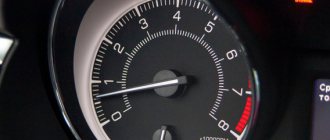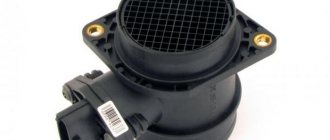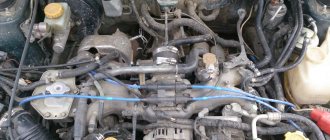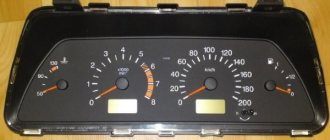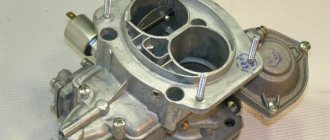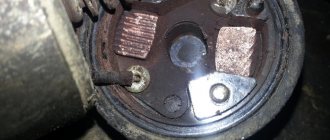P0336 - Crankshaft Position Sensor "A" Performance/Range Problem.
Code P0336 indicates a problem with the crankshaft position sensor (CPS). The DPCV monitors engine speed and controls the engine valves to make sure the pistons are working properly.
The crankshaft sensor transmits important information to the engine control unit (ECU), which allows the controller to adjust fuel injection as well as ignition timing. DPCV, working properly together with the ECU, ensures excellent engine performance.
When the crankshaft sensor fails to provide the correct information to the control unit, a P0336 code is generated.
Lada 2112 ᵀᴴᴱ ᴼᴿᴵᴳᴵᴺᴬᴸ › Logbook › Why does the VAZ 2112 start and stall
A malfunction in which a VAZ-2112 passenger car stalls a couple of seconds after starting the engine gives the driver a lot of negative emotions. But in order to find the cause of this malfunction yourself, you need to know why this can happen. If you do not have this knowledge, then there is only one way out, go to good specialists who can diagnose the engine.
The first cause of this malfunction may be the idle air regulator (IAC), which is located on the throttle assembly. You can make sure that it is he who is causing the malfunction as follows. Open the hood of your VAZ-2112, look for the air filter, between it and the intake pipe hose there is a mass air flow sensor (MAF).
You remove the terminal from it and try to start the engine of your car. If the engine starts and, with the gas pedal released, keeps the crankshaft speed in the region of one and a half thousand, this will mean that the idle speed control is in working order. Since it is he who maintains such speed when the terminal is removed from the mass air flow sensor. A similar check can be carried out when removing the terminal from the throttle position sensor (TPS). It is located on the side of the throttle body pipe.
If the engine, during these two checks, also starts, and then immediately stalls, then the idle air control valve or the wires going to it may be to blame. But in order to pass a final verdict on it, you will need to check the condition of the throttle assembly, since it has a tendency to become dirty, which prevents the rod from moving. In this case, even a working idle speed controller will not be able to perform its intended function of regulating the engine crankshaft speed.
If it turns out that the idle air regulator is to blame for this malfunction, and you purchased a new IAC, then before installing it instead of the faulty regulator, you will need to disconnect the battery by removing the negative terminal. Time the removal of this terminal and begin installing the new IAC. If you did this work quickly, then put the negative terminal back in place no earlier than 20 minutes from the moment it was removed. Next, turn on the ignition and keep it on for about twenty seconds. Then turn off the ignition and only after these steps do you try to start the engine of your car. This is done in order to reset the electronic control unit (ECU), otherwise it will generate this error again.
The situation when the engine stalls at idle occurs quite often. This phenomenon can occur both on cars with high mileage and on new cars. It is worth noting that the process of starting a cold engine with a starter can be either initially difficult or proceed absolutely normally.
In other words, the engine may run fine or hot, but then starts to stall at idle. Also in a number of cases, it appears that when you press the gas pedal and increase the speed, the engine begins to operate stably. There are several main reasons why the engine “does not hold” idle speed, troits and shakes. Next, we will look at why the car stalls at idle or runs very unevenly after starting “cold”, during transition modes “hot”, etc.
About notOshibka.Ru
Consent to the processing of personal data
I hereby confirm and give my voluntary consent to the website neoshibka.ru (Internet address https://neoshibka.ru/) in accordance with Article 9 of the Federal Law of July 27, 2006 N 152-FZ “On Personal Data” for processing and the use of my personal data specified during the registration process, commenting, or when filling out any other contact form on this site, with or without the use of automation tools, including collection, recording, systematization, accumulation, storage, clarification (updating, changing ), extraction, use, transfer (distribution, provision, access), depersonalization, blocking, deletion, destruction of personal data in order to collect statistics and improve the services provided by the site. The processing of personal data is also carried out for the purposes of my information notification (distribution of information, if desired, there is an unsubscribe function) and for conducting analytics and statistics.
I am aware that:
- This consent to the processing of my personal data specified during registration on the Site, sent (filled out) using the Site, is valid for 20 (twenty) years from the date of registration on the Site;
- Consent can be withdrawn by me based on a written statement in any form;
- Providing personal data of third parties without their consent entails liability in accordance with the current legislation of the Russian Federation.
Check Engine (translated as Check Engine) is an indicator located on the dashboard, well known to all owners of modern cars. Sometimes it is simply called Check or MIL (Malfunction Indicator Lamp).
This light comes on when any problem occurs in the car's engine. In this case, car manufacturers recommend urgently contacting a service station (service station). At the service station, a special device is connected to the car's diagnostic connector - a scanner, with which they read the fault code (error code) registered by the car's self-diagnosis system, indicating the cause of the malfunction, or an On-Board Diagnostic Computer is installed in the car thanks to which you can read the error code ( see the transcript in the instructions), or view an already decrypted error (modern on-board computers decrypt the error on their own).
The easiest way to check the error is whether it is real or just a malfunction in the system. You need to do the following:
1. Remove the terminal from the battery for 10-15 minutes.
2. Put on the terminal and check whether the Check Engine light is on or not.
Gasoline engine does not idle
Let's start with the fact that this malfunction indicates two possible causes: failure of individual mechanisms, components or sensors, as well as severe contamination of certain elements. In both the first and second cases, it is necessary to carry out a diagnosis. The engine on injection and carburetor cars can most often stall at idle in the following cases:
- the idle air regulator (IAC) has failed;
- the throttle valve is dirty or malfunctioning;
- the carburetor channels are clogged or the fuel jet XX is dirty;
- the performance of injection nozzles is reduced or impaired;
- the mesh of the electric/mechanical fuel pump is clogged, malfunctions of this unit have occurred;
- there was a decrease in the throughput of the fuel filter;
- the air filter is dirty, air leaks at the inlet;
- failure of the mass air flow sensor, throttle position sensor, etc.;
- clogging of the engine crankcase ventilation system;
We also recommend reading the article on how to replace the mesh filter on the fuel pump yourself.
From this article you will learn about methods for removing the fuel pump to replace the mesh, and also find useful tips for successfully implementing this process. If the car immediately stalls or the speed fluctuates noticeably after the starter is turned off, then you should pay attention to the throttle assembly. It is possible that the valve may become clogged or the mechanism may become jammed. This malfunction, especially severe contamination, occurs as a result of prolonged driving on low-quality fuel, as well as untimely replacement of the air filter.
In this case, the throttle valve needs to be cleaned. To clean the throttle, use a regular “carbicleaner” (a product for cleaning carburetors), and you also need to blow out the valve using compressed air from the compressor. If these steps do not help, then you will need to evaluate the condition of the oil trap. This element is an integral part of the engine crankcase ventilation system. A dirty oil trap causes crankcase gases to “choke” the engine, idle speed floats and the internal combustion engine stalls.
Malfunctions of auxiliary systems and ignition
- P0300 - no spark in all cylinders;
- P0301 - no spark in cylinder No. 1;
- P0302 - no spark in cylinder No. 2;
- P0303 - no spark in cylinder No. 3;
- P0304 - cylinder No. 4, no spark;
- P0326 - knock sensor readings are outside the permissible limit;
- P0327 - poor signal in the circuit of the same device;
- P0328 - signal too strong in the same circuit;
- P0335 - crankshaft sensor circuit is faulty;
- P0336 - crankshaft sensor readings are outside the permissible limit;
- Camshaft sensor location
P0337 - crankshaft sensor shorted to ground;
- P0338 - the network of the same device is interrupted;
- P0342 - weak signal in the phase sensor network;
- P0343 - the signal in the network of this device is too high;
- P0346 - the readings of the same device are out of the permissible limit;
- P0351 - break in the wiring of the ignition coil of cylinder No. 1;
- P0352 - open circuit of coil No. 2;
- P0353 - break in the wiring of coil No. 3;
- P0354 - open circuit of coil No. 4;
- P0363 - lack of spark and fuel supply in faulty cylinders;
- P0422 - the converter is broken;
- P0441 - incorrect air flow through the canister purge valve;
- P0444 - the canister valve wire is broken;
- P0445 - it has shorted to ground or BS;
- P0480 - open circuit in fan relay wiring;
- P0481 - fault in the same wiring.
So what happens to the car?
Often everything happens according to a standard scenario: you get behind the wheel, turn the ignition key, and the engine starts working as usual. However, as soon as you take your foot off the gas pedal, the engine speed immediately begins to drop. It should be noted that in this situation, the idle speed sensor still produces the nominal number of turns. Under all these circumstances, the idle speed jumps, creating distorted operation of the car as a whole. Due to detonation of the propulsion system, which occurs against the background of idle speed surges, the most unpleasant, but quite natural thing happens - the engine stops working and the car stops.
Clogged throttle valve
Usually the situation returns to normal after another attempt to start the engine and set the car in motion - everything falls into place, and you can safely follow the intended path. However, such an incident can be considered the first bell, since in the future such an emergency situation will again take you by surprise. Therefore, at the first manifestations of such a problem, you should immediately address them. Before you begin to troubleshoot problems, it is worth finding out the true cause of their occurrence.
Diagnostics using the built-in BC
To view the error codes, you need to find the daily mileage reset button on the dashboard, press it and, holding it, turn the ignition key. The self-diagnosis mode will turn on. All arrows on the instruments should move from minimum to maximum values and back, and all positions on the LCD display should light up. You need to look: if any position does not light up or the arrow on any device does not move, then you should check the corresponding sensors, their networks or display for malfunctions.
Priora on-board computer
In the same mode, press any button for switching modes of the built-in BC 2 times, after which digital codes may appear on the liquid crystal display:
- 2 - very strong voltage in the BS;
- 3 - errors in the fuel level sensor system in the gas tank;
- 4 - error in the coolant temperature sensor system;
- 5 - error in the air temperature sensor system outside the car;
- 6 — motor overheating;
- 7 — emergency low oil pressure;
- 8 - malfunctions in the brake system;
- 9 - battery is low;
- E - error in the data packet stored in the EEPROM.
Many drivers ask how to reset error codes on a Lada Priora. Perhaps their built-in BC is faulty, since a working on-board computer automatically exits the diagnostic mode after 30 seconds if you do not press any control buttons.
If the engine does not idle
Both experienced service station workers, professional drivers with many years of experience, and even amateurs identify a group of circumstances due to which the engine does not maintain idle speed. This includes:
- malfunction of the idle speed sensor;
- throttle valve clogged;
- malfunction of the throttle position sensor;
- contamination of the injector or carburetor
The reasons for the breakdown can be completely different, so when eliminating them you will have to use all sorts of actions and techniques. If you have considerable driving experience behind you, and you know the operating features of the car like the back of your hand, regardless of the model, then troubleshooting this kind of problem will not cause you any problems. And all because such breakdowns are not complex or serious. It follows that you can get your car working without outside help. Well, if your level of awareness or lack of free time does not give you the opportunity to eliminate all the defects yourself, it is better to seek help from knowledgeable people who can save you from unpleasant moments in the shortest possible time.
Allow the check engine light to go off on its own.
Wait until the “check” goes out on its own. The simplest method because you don't have to do anything. The computer system in most vehicles will automatically recheck for problems that may activate the error light. If it is a minor problem, it will automatically correct itself and the check will go off. However, if the check light is still on after three days, you need to apply the methods mentioned above to reset it.
If this continues to happen despite the following reset procedures, you should take your vehicle to your nearest auto repair shop and have it diagnosed by a professional mechanic. Professional diagnostics use more sophisticated tools and can identify precise problems.
REMEMBER: You can always contact our car service center, where your car will be happy to receive professional technical assistance. You can also make an appointment with us for a scheduled technical inspection! Please familiarize yourself with our car repair and diagnostic services.
To check instrument panel error codes, you need to enable test mode. To do this, you need to press the daily mileage reset button and, without releasing it, turn on the ignition. All familiar positions should light up on the liquid crystal display (LCD), and the arrows of the tachometer, speedometer, coolant temperature indicator and fuel level indicator should move from minimum to maximum values and back. The serviceability of the LCD and the above sensors is visually checked.
Press any key to switch functions of the on-board computer (BC). The program version is displayed on the LCD.
Press the BC function switch button again. The LCD should display (if present) the following error codes:
2 – increase the voltage of the on-board network,
3 – fuel level sensor error*,
4 – coolant temperature sensor error*,
5 – error of the external temperature sensor (if there is no sensor reading within 20 seconds, indication on the LCD is “-C”),
6 – engine overheating**,
7 – emergency oil pressure**,
8 – brake system defect**,
9 – battery is discharged**,
E – detection of an error in a data packet stored in EEPROM.
*- if an open circuit of the sensor is detected within 20 seconds
**- the criterion for triggering the acoustic alarm is met
If necessary, you can reset error information. To do this, press and hold down the daily mileage reset button for 3 seconds.
The next time you press any of the BC control buttons, all familiar positions should light up on the LCD - the system has returned to its initial state.
If you do not press any control buttons for approximately 30 seconds, the instrument panel enters the operating state.
How to solve a problem?
To figure out why the engine stalls, it is recommended to contact a specialist. In this case, you can save your nerves and save the time that is always missing, without racking your brains over possible ways to solve this problem. A high-quality service station, with the appropriate equipment and professional workers, will be able to solve any problem and get your machine working in the shortest possible time. Here's what the auto center can do:
- complete replacement of equipment that has become unusable;
- regeneration of failed devices;
- carrying out preventive procedures and bringing equipment into proper condition
The most optimal solution to this problem would be to completely replace non-working equipment. You can install a new idle speed sensor, throttle valve, throttle position sensor, injector or carburetor. In principle, most developed countries resort to this method today. With all this, it can be quite difficult to complete such a procedure in Russia due to the lack of spare parts necessary for your car, or if they are available, they are of very dubious quality.
The video shows a solution to the engine problem at idle speed:
Whatever one may say, you will still have to restore worn parts on a car if it is not operating satisfactorily at idle. And most often, given financial capabilities, the owner of the car will take the risk of getting down to business with his own hands, so as not to spend a certain amount of money on specialists for the work done. Therefore, it is worthwhile to think about possible losses in the future. Remember: timely maintenance, cleaning of parts and strict adherence to the car’s operating instructions will help you avoid unpleasant situations. The type of engine - diesel or gasoline - does not play a special role in this case.
How are errors diagnosed?
If problems and unusual malfunctions begin to appear in the usual operation of your car, think about carrying out diagnostics of the systems. Remember that not every machine has special pads for working with a specific professional connector, so it makes sense to use a standard connector. Why is code combination analysis so important? It is displayed on the on-board computer monitor, clearly demonstrating the problem and its location, which helps the owner to quickly carry out repair work. For a more detailed scanning of the breakdown, you can connect a special device - a scanner connected to the connector.
Self-diagnosis of the car
The system makes adjustments independently, automatically. Its structure includes other electronic devices. Thanks to special ECU sensors, the device’s memory receives information, including faults (shown in the form of numerical combinations). Most often, manufacturing companies are reluctant to provide complete information about the designation of codes and ciphers, as they consider professional inspection and care to be of better quality than independent care.
Experts recommend contacting the Lada service center to avoid fraud. Most cars are equipped with a bot controller - a unit that processes the information received by the sensors and displays it on the monitor. The Lada model does not have such a device, so it is appropriate to use scanning equipment. Let's take a closer look at the process itself:
- turn on the ignition, press “Reset” (needed in order to reset the mileage for the last day), hold it for a while;
- A self-diagnosis mode, segment icons, and indicators will appear on the instrument panel. The arrows will start moving;
- you need to switch between selected modes using a button located under the steering wheel on the right side;
- press the “errors” mode, reset them - hold down the above button for a little more than 3 seconds;
- Return from the set mode will occur automatically if the device is in idle mode.
How to diagnose via the dashboard
Diagnostics can be performed via the instrument panel. In order to start the verification process, it is recommended to click the button for recording the car mileage per day. Hold it a little and slowly turn on the ignition. If the manipulation is performed correctly, the instrument panel arrows (tachometer, speedometer, other indicators) will move in a circle, shifting from beginning to end. When the process is complete, switch the screen to another position using the button on the wiper adjustment surface (located at the bottom of the steering wheel). When you press it, an icon with the operating parameters of the ECU devices will appear on the instrument panel. One more thing: software with the inscription “self-diagnosis” always appears.
Diagnostics using a computer
For self-diagnosis, you can also use a laptop or PC. It is convenient to use a tablet. All you need is a USB cable to connect to the device and a previously installed testing program. There are a variety of firmwares, for example, a service for VAZ, developed specifically for certain car models (including Kalina). Connect the cable to the special connector located under the gearbox using the lever. Exact location: place above the cigarette lighter. The algorithm is like this:
- install the service on the device;
- in front of the lever, open the plastic cover, open the K-Line outlet;
- connect the wire to the block. Connect the first edge to the connector, the second to the gadget;
- You can start diagnostics and check the connection. Go to the “Tasks” menu, click the “Hardware” tab, view the connection. If it is, continue testing;
- start the firmware process. Monitor the reading of codes by the service; if this does not happen, click the “File” button, click the “diagnostics” field. A table with fault codes will pop up on the screen;
- There is a “parameters” button in the menu, which indicates the general condition of the car. If you need to view faults, click the “Codes” button.
When all the information is displayed on the monitor, it needs to be decrypted. The next steps are clear: a reference book or technical table is used, and the problem is resolved using the information provided.
Functionality check
We have already talked about where the sensor is located. The first thing you need to do is find it and remove the block with wires. On a VAZ 2110, you must first unscrew the fastening elements of the throttle assembly, then move the entire assembly by about 10 mm.
Check with a voltmeter that the voltage is appropriate to the sensor. To do this, you must first connect the negative terminal of the battery to ground and connect a voltmeter to terminals A and D (they are usually marked), then:
- If the voltmeter shows less than 12V, this most likely indicates that the battery is not charged;
- If nothing is shown, faults should be looked for in the electronic control unit or in the circuit;
- If the reading is 12V or more, you need to check the regulator directly, or more precisely, its resistance;
- We connect a tester to the four terminals, which should give a total resistance reading of 50 or 55 Ohms.
Testing in pairs should give an infinitely large resistance. If the idle speed sensor on a VAZ 2110 (injector) gives different readings, it means it needs replacement.
You can also test the regulator in another way: remove the sensor and connect the block. Pressing the needle with your finger, watch its extension. When the ignition is turned off, there should be a push of the needle.
If everything is normal, then usually the speed does not fluctuate and the sensor itself is in working condition. If there is no shock, you can try cleaning the mechanism.
This is done using a special cleaner called WD-40. They very carefully, using a cotton swab, clean everything that is possible in the sensor.
Particularly carefully - the rod, as well as the needle. But if this does not help, a replacement is needed.
Checking using a connected computer or tester
Driver Information Panel
Checking system malfunctions using connected devices gives more accurate results, but at the same time requires deciphering special codes. For example, the monitor displays code p0441 or p0130 or error p0422. Oh, these car manufacturers, in human language they could write “replace the oxygen sensor” instead of P0130 or “check the canister valve” instead of P0441. But nothing can be done, the Lada Priora is also intended for export, so it is easier to write p0441 in the program than to give explanations in Russian, Kazakh, Arabic, Armenian and 10 other languages. And then attach special tables that indicate the meaning of certain codes. Just look at them and everything will become clear. But these tables are not included with the operating instructions. Either way, you can check them out below.
The Latin letter comes first:
- P - error in the electronic systems of the motor;
- C - error in the electronic systems of the chassis;
- B - error in interior electronics;
- U is an error in the joint operation of different systems.
Next comes the number:
- 0 - OBD-2 code;
- 1 - enterprise code;
- 2 - enterprise code;
- 3 - reserve code.
The system indicates an error
The next digit indicates the system in which the malfunction was found:
- 0 — exhaust;
- 1, 2 — fuel and air supply system;
- 3 - ignition;
- 4 - additional control;
- 5 — idle system;
- 6 - ESC;
- 7, 8 - transmission.
The last 2 digits indicate the serial number of the fault.
VAZ 2110 stalls at idle
Possible reasons for the VAZ 2110 engine stopping at idle
Let's look at one of the common problems for the VAZ 2110 car. This is a Russian-made sedan, usually with a 1600 cc engine and a 5-speed gearbox.
It often happens that when stopping in neutral gear, the tachometer drops the revolutions to 500, and then the readings become standard - 800-900 rpm. After some time, the car begins to stall altogether.
The first thing car enthusiasts do in such a situation is to decide that the problem is that the injectors are dirty and cannot spray fuel as expected. This can happen due to many impurities in gasoline, the quality of which has recently left much to be desired. If the assumption is correct, then the control unit, receiving a signal from the injectors, increases the amount of fuel supplied, which can cause the engine to stop. If after cleaning the injectors the picture does not change, and the car continues to stall when braking at traffic lights and pedestrian crossings, another reason should be considered.
Another “troublemaker” can be the idle speed sensor. You should just replace it and see how the car behaves. If you don’t want to spend money on a new sensor without making sure that the old one is faulty, just ask the lucky owner of a working car for half a day. “Tens” remains a popular model and I think you can borrow this sensor from someone you know. If the experiment showed that the problem is not at all with the idle speed sensor, then you should contact computer diagnostics.
Error P1602: what does it mean, decoding
The appearance of error code p1602 when scanning with a diagnostic device or during self-diagnosis using an on-board computer is a fairly common problem. Despite the fact that in the absence of other symptoms of malfunctions, you can use the car without problems, the message itself with error code P1602 begins to irritate. Especially when this has not been happening for the first month. Theoretically, error code 1602 stands for a message from the ECU about an interruption in the on-board network voltage. In practice, this means that in some place there is no contact on the terminals, plugs, connectors.
The message may also mean that one or more electrical devices on the on-board network may not have contact with ground, temporarily or permanently. Naturally, if the battery is not in full contact with the vehicle’s ground, we will not see any message, since the electrical equipment will simply die without signs of life. True, this happens extremely rarely, but it doesn’t hurt to remember it. As well as temporary problems with charging the battery, which can be associated both with the battery itself and with the charging relay, generator or their contacts.
Checking the idle air control
One of the reasons that the car stalls at low speeds is a malfunction of the idle air control (IAC). It should be tested to either rule out this cause or troubleshoot. There are several ways to check the serviceability of the IAC on the VAZ-2110:
- With the ignition off, connect the multimeter probes to the power supply. When they are connected, turn on the ignition and check the integrity of the winding and the power supply circuit in the following order: first, the probes are connected to pins 1 and 2. When the IAC is working properly, readings from 50 to 80 ohms appear on the multimeter sensor. When testing the 2nd and 3rd pins, as well as the 1st and 4th pins, there should be indicators indicating an infinite value.
- Visual inspection method. It is necessary to remove the regulator, disassemble it and determine the degree of coking, the degree of wear of the spring and other elements of the regulator. It is quite easy to visually determine that the regulator is simply time to change.
- It is still possible to carry out diagnostics using special testers, but purchasing such a tester will cost much more than replacing the part itself. It's up to you to decide whether it's worth purchasing such a device.
Recommended Tools to Fix P0336
There are several important tools that you should keep on hand. They will help you fix the P0336 trouble code. These tools include:
- Car charger.
- Multimeter.
- OBD-II scanner.
- Oscilloscope.
- Electrical contact cleaner.
Previous post Error P0137 - what it means, symptoms, causes, diagnosis, solution
Next entry Error P0170 - what it means, symptoms, causes, diagnosis, solution
Testing the mass air flow sensor (MAF)
Let us remind you what we are talking about - VAZ-2110 8-valve injector: the speed drops and stalls. A reasonable question arises: what to do? If the reason is not the IAC, then it is worth testing the mass air flow sensor. Here are some recommendations on how to do this:
- Disconnect the sensor connector from the on-board system. The controller that controls the engine will operate in emergency mode, but for short testing this is not fatal. If your car runs much faster, then the problem is most likely in the mass air flow sensor. It's time to clean it.
- Replace the sensor with a working one, and then see how the engine works. There are improvements, which means you need to either clean or replace your own mass air flow sensor.
- It also makes sense to inspect the air intake; to do this, you need to remove the mounting clamp and carefully inspect the inside of the air intake, there should be no condensation or oil there. If any are found, then it will have to be cleaned with special means.
- You can also test the mass air flow sensor using a multimeter. To do this, you need to switch the multimeter to voltmeter mode and set it to 2. The sensor has 2 wires - yellow and green. Yellow transmits a signal to the controller, and green transmits a signal to ground. When the ignition is turned on, we take measurements between these two wires. The engine should not be running. If the readings are in the range of 1.01-1.02, then the sensor is in perfect order. Readings in the range of 1.02-1.03 – it’s time to clean the sensor. And if the indicators go off scale to 1.04, then it’s time to get a new sensor.
Now we have figured out the main symptoms of a malfunction of the mass air flow sensor; neither testing nor troubleshooting is particularly difficult. It is quite possible to cope without after-sales service.
Diagnostics and decoding of codes on Lada Priora
Like any modern car, the Lada Priora is equipped with dozens of various sensors, the functioning of which determines the condition of the main vehicle systems. Diagnostics of the machine for errors allows you to detect all sensor faults in order to eliminate breakdowns. Now you will learn how Priora error codes are deciphered and how to independently diagnose the on-board computer (hereinafter referred to as BC).
Various breakdowns of sensors and other devices can cause increased gasoline consumption, incorrect engine operation, and increased wear of car system components. Despite the presence of errors, the VAZ Priora will drive until the driver has to make expensive repairs because of them.
VAZ Priora car
So that the motorist does not suddenly have to face the need for repairs, a special controller is installed on the VAZ Priora, with the help of which the driver can diagnose breakdowns. This can be done either using special additional equipment or an on-board computer installed in the car.
In fact, to carry out diagnostics, the car owner will only need to press a few buttons and count combinations of faults.
For example, you do not have a special tester, so we will look at diagnosing the vehicle for errors using the on-board computer. The BC is built into the dashboard and can be used to read combinations of faults. To do this, you need to activate the auto test mode.
First, turn off the ignition. After this, hold down the daily mileage reset button and turn on the ignition
Please note: the button must be held down. There is an LCD indicator on the vehicle's dashboard, keep an eye on it. When you turn on the ignition, all icons will start to light up, and all arrows (speedometer, tachometer, antifreeze temperature sensor, gasoline level status) will begin to move to the maximum values and back
That is, if all the arrows behave as described here, this means that the sensors and indicators are functioning correctly.
Now you need to find the button for switching BC functions - it is located on the right steering column switch. By clicking on it, the software version (1.0 and higher) will be displayed on the screen. Click on this button again. Combinations of faults will begin to appear on the screen. If necessary, you can reset error data here. To do this, press and hold the daily mileage reset button for about three seconds.
The appearance of a fault combination on the LCD screen during self-diagnosis
Checking the serviceability of the throttle position sensor (TPS)
Our problem may be caused by a faulty DPSD. But it is this sensor that is tested last, when everything has been tried and tested. But in vain, it is easy to test, you can save a lot of time and money if you check this sensor. How to do it:
- This sensor is located on the throttle pipe, it is connected to the throttle axis. The sensor is secured with two screws. When removing the sensor, you should pay attention to the condition of the throttle valve, whether it is coked. If yes, then there will be the same symptoms as with problems with the sensor. However, the sensor can be checked without removing it.
- To do this, you need to measure the voltage at the DPSD terminals when you turn on the ignition, and it should not exceed 0.7 V.
- Next, open the throttle using the plastic sector, and then measure the voltage again. It must be at least 4 V.
- Next, check the voltage at the DPZD terminals when the damper moves. It should not change; abrupt changes indicate a sensor malfunction.
Having found out that the sensor is faulty, it should be replaced. On the VAZ-2110, 2 types of DPZD are installed - film-resistive and non-contact. The first is designed for 55 thousand mileage, the second is unlimited, but much more expensive than the first.
Well, dear friends, we have presented some tips for servicing your car yourself. I hope you find them useful.
Source
Diagnosis of errors
When you begin to notice something unusual in the behavior of your car, or there are obvious problems in its operation, then it certainly makes sense to have it diagnosed. Naturally, the OBD-II diagnostic connector will show errors most efficiently and accurately, however, not everyone has sockets to control this connector and has to use the standard one.
In order to enter self-diagnosis mode, you must:
- Turn off the ignition.
- Click on the daily vehicle mileage button.
- Then, continuing to hold it, turn the key in the lock.
- Thanks to this, all available indicators will light up, and the dial indicators will go into self-test mode and show data from zero to maximum.
- When this happens, use the button located on the steering column switch and use it to switch the data on the instrument panel.
- To read the fault codes, we need the last one - the third screen. Unambiguous error codes will be displayed there.
Displaying the error code on the third screen of the bookmaker. The photo shows error 4 (faulty coolant temperature sensor).
Error codes (decoding)
These are the most common error codes that can appear if there is a malfunction on the Lada Kalina.
Code Explanation 2 Excess of voltage in the vehicle's on-board network. 3 Malfunction of the gasoline level sensor in the fuel tank
Possible circuit break. 4 When this code appears, the car owner needs to pay attention to the operation of the antifreeze temperature sensor. There is also a possibility of a circuit break. 5 There is a problem with the outside temperature sensor. 6 The control unit has detected engine overheating
It is recommended to deal with this problem before further operation of the car. 7 Emergency lubricant pressure in the internal combustion engine is reported. 8 If you see this code on the dashboard, then you need to check the functionality of the brake system. The on-board computer recorded an error or breakdown in its operation. 9 The on-board computer reports that the battery charge is too low. It is recommended to perform a more thorough check of the battery. E An error has been reported in the data packet stored in the EEPROM.
Checking the system using special equipment
If the system is checked through a diagnostic block using OBD-II, then the code combination will consist of four characters, preceded by a letter at the very beginning.
P - indicates a problem with the engine or transmission. C - displayed when an error occurs in the “running”. B - when such a letter designation appears, you should pay attention to the serviceability of the central locking system, airbags, and power windows.
The second digit means:
- 0 – common code for OBD-II;
- 1 – number of the car manufacturer;
- 2 – number of the car manufacturer;
- 3 – reserve code.
The third character refers directly to the type of failure:
- 1 – malfunction in the air supply system and fuel system.
- 2 – similar to code “1”.
- 3 – failures and malfunctions in the ignition system.
- 4 – auxiliary control.
- 5 – malfunctions during idle operation.
- 6 – malfunction of the ECU or its circuit.
- 7 and 8 – malfunction in the transmission.
Causes of error P0336
- Worn or damaged gear
- Foreign object in contact with gear
- Short circuit or open circuit of the crankshaft position sensor
- Short circuit, break or damage to the crankshaft position sensor wires
- Corroded or damaged crankshaft position sensor connector
- Misfires in engine cylinders
- Malfunction of the crankshaft position sensor
- Camshaft position sensor malfunction
- ECM malfunction
Common errors when diagnosing code P0336
The most common mistake when diagnosing a P0336 code is to replace the crankshaft position sensor without considering other possible causes of the error.
The problem may be a malfunction of the camshaft position sensor, misfire in the engine cylinders, or worn or damaged electrical wires.
Before replacing the crankshaft position sensor, it is necessary to perform a thorough diagnosis and consider all possible causes of the error.
What could have broken?
If the machine does not work, it means the motor is broken. This can often be heard from an inexperienced driver. But in a car, in addition to the engine, there are many different elements, on the serviceability of which the operation of the power unit depends. If the car is not completely “dead” and when the starter rotates it shows signs of life, “sneezes” or “shoots” into the exhaust pipe, the fault will be more difficult to find.
The malfunction that led to the engine shutdown is hidden in one of the three systems of the VAZ 2112:
- electrical equipment and power supply;
- fuel supply system;
- gas distribution mechanism and piston group.
You must understand that if the level of coolant or oil in the crankcase is low, the engine will not stall; it may fail due to overheating or lack of lubrication. Therefore, it is important to recall the circumstances preceding engine failure. It’s one thing when the power unit just stopped moving, another thing if before that you heard extraneous knocks or shots in the exhaust. In the first case, the electrical part is probably to blame.
A sign of the second situation is often a broken timing belt, which is easy to detect by removing its upper plastic casing. The belt can be changed on the way if you have a spare one, otherwise you will have to look for a part or a towing company. If the starter cannot crank the engine when trying to start, there may be two reasons:
- there was a breakdown in the generator circuit, and the voltage source was the battery, which as a result was discharged;
- the crankshaft jammed due to lack of lubrication.
In both situations, you need to find a way to deliver the car for repairs; you won’t be able to do anything on the road.
Additional comments for troubleshooting P0336
The existing fault must be corrected as soon as possible. If the problem is left unaddressed for a long time, it can cause damage to other engine components. When replacing the crankshaft position sensor, it is recommended to use only original spare parts.
Also, when diagnosing the P0336 error, it is important to consider all possible causes of the malfunction, since sometimes the problem may be a damaged gear or misfire in the engine cylinders.
What repairs can fix the P0336 code?
- Replacing a worn or damaged gear
- Repairing or replacing damaged crankshaft position sensor wires
- Repairing or replacing a damaged or corroded crankshaft position sensor connector
- Repairing or replacing a damaged or faulty crankshaft position sensor electrical circuit
- If necessary, eliminate misfires in engine cylinders
- Replacing a faulty crankshaft position sensor
- Replacing a faulty camshaft position sensor
- ECM replacement and reprogramming
Causes of P0507
- Air leaks, vacuum leaks (most common).
- Malfunction, jamming of EGR (exhaust gas recirculation).
- Faulty PCV valve (forced crankcase ventilation).
- Faulty/damaged/dirty throttle body.
- Faulty EVAP (gasoline vapor recovery system).
- Faulty IAC (IAC - idle air control).
- Power steering switch faulty.
- Accelerator pedal malfunction.
Carburetor problem
And although new cars no longer use carburetors, old ones still drive using these engine fuel systems. These are quite problematic systems that constantly become clogged. Many service stations offer carburetor cleaning services, after which the engines on many cars come to life. However, you can clean the carburetor yourself - there are special aerosol cleaners for this. The difficulty lies only in removing the system, although if you have the tools there should be no problems.
On which cars is this problem most common?
The problem with code P0507 can occur on different machines, but there are always statistics on which brands this error occurs more often. Here is a list of some of them:
- Audi (Audi a4)
- Chery (Chery Amulet, Tiggo, Fora)
- Chevrolet (Chevrolet Aveo, Cruz, Optra, Tahoe)
- Chrysler (Chrysler 300c)
- Daewoo
- Dodge (Dodge Caliber)
- Ford (Ford Focus)
- Geely
- GMC Sierra
- Honda (Honda Accord, SRV)
- Hyundai (Hyundai Accent, Getz, Santa Fe, Sonata, Tucson, Elantra)
- Infiniti (Infiniti fx35)
- Isuzu (Isuzu Trooper)
- Jeep (Jeep Grand Cherokee)
- Kia (Kia Magentis, Sorento, Spectra, Sportage)
- Lifan (Lifan Solano)
- Mazda (Mazda 3, Mazda 6)
- Mercedes (Mercedes e210)
- Mitsubishi (Mitsubishi Galant, Montero)
- Nissan (Nissan Hell, Altima)
- Opel
- Pontiac (Pontiac Sunfire, Grand Prix GXP)
- Saturn (Saturn SC)
- Skoda (Skoda Octavia)
- Subaru
- Volkswagen (Volkswagen Passat, Touareg)
- VAZ 2107, 2110, 2112, 2114, 2115
- Gazelle ZMZ 405
- Lada Kalina, Niva, Priora
With fault code P0507, you can sometimes encounter other errors. The most common ones are: P0068, P0106, P0118, P0171, P0174, P0300, P0301, P0420, P0505, P0506, P1125, P1515, P1295, P2279.
